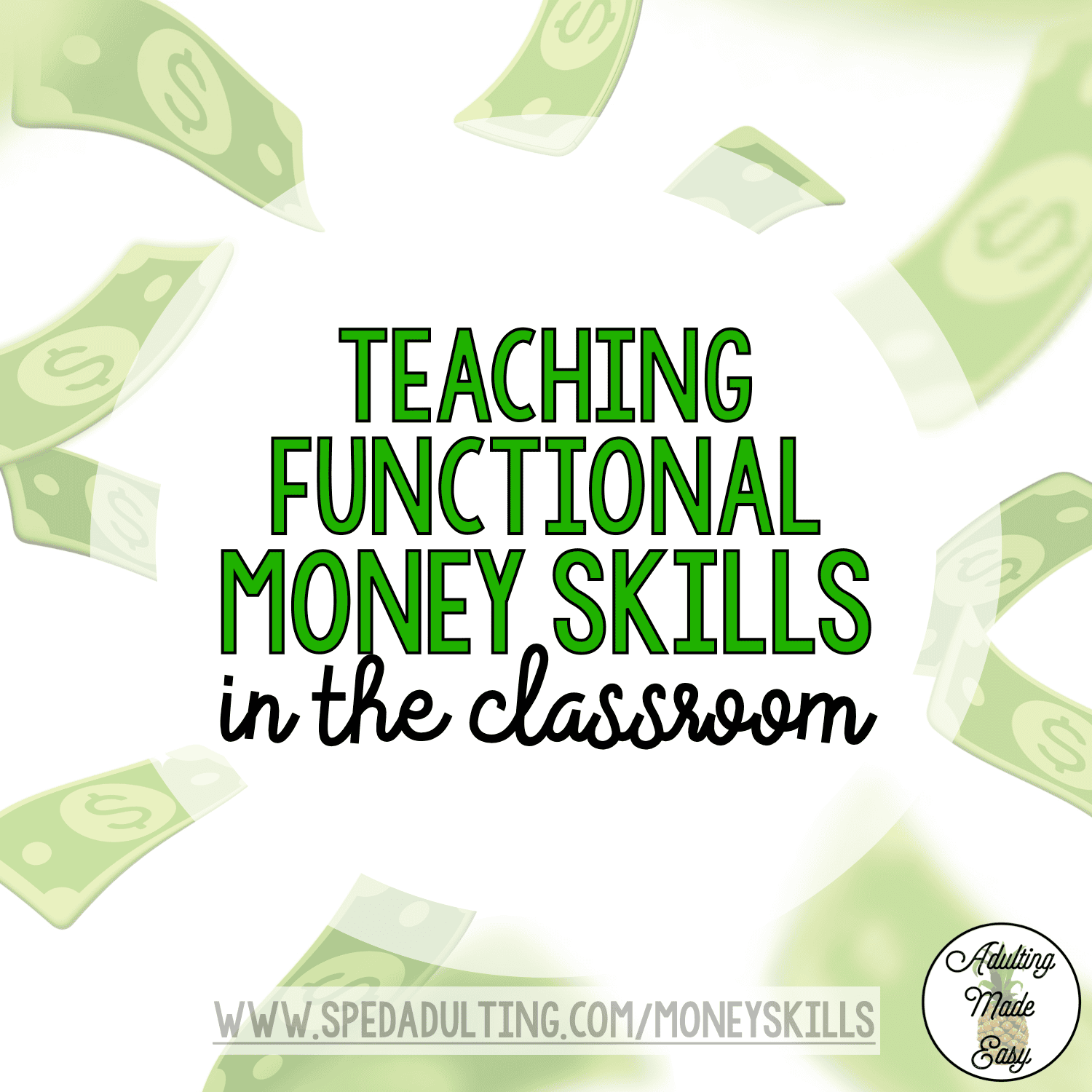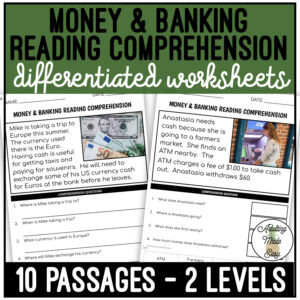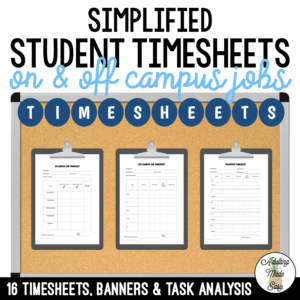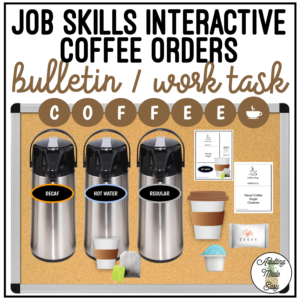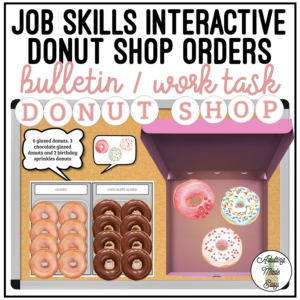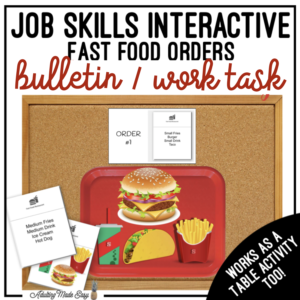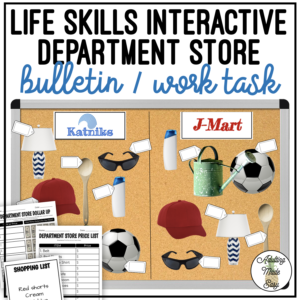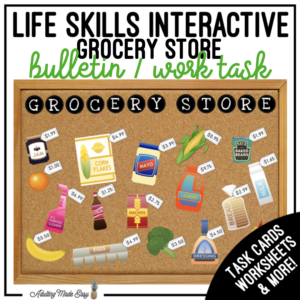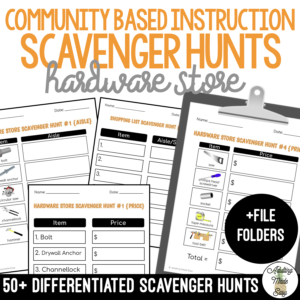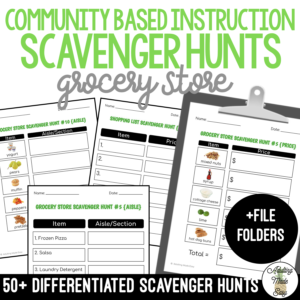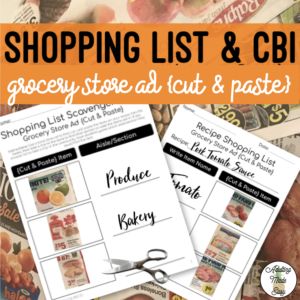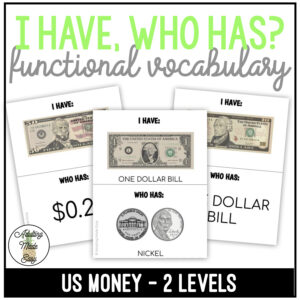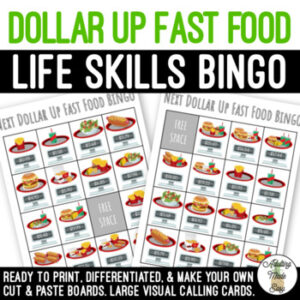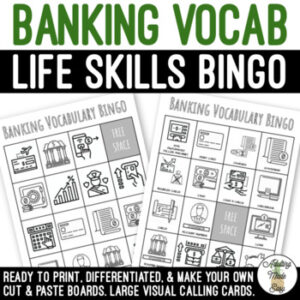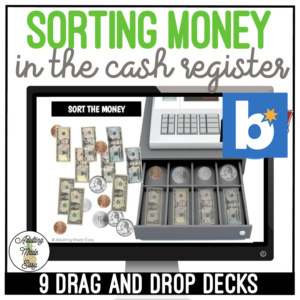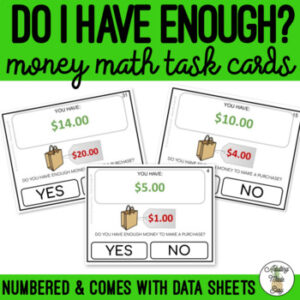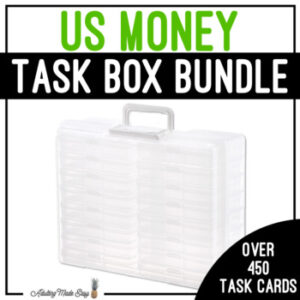Money skills are a vital part of independent living. It’s not just about recognizing coins and bills or understanding how to budget—students also need to develop the motor and social skills involved in handling money. While completing worksheets with money-related word problems is helpful, applying those skills in real-world settings is a much more complex task. Here are some engaging ways to practice functional money skills in the classroom and help prepare your students for success in the community and beyond!
Digital Activities, File Folders, Task Cards > Worksheets
I’m not the biggest fan of worksheets—mostly because they’re often not very motivating for my students (and let’s be honest, they’re not the most eco-friendly either). That said, I do use them occasionally, depending on the individual needs of my students. What I really love, though, are digital activities and task cards. They’re visually engaging and typically present just one question with a few answer choices, which works well for many of my learners.
Digital tools are especially helpful for students who aren’t able to write, as they can point, tap, or circle their answers instead. They’re also accessible for students who need audio support—the questions and answer choices can be read aloud, which is perfect for those working on reading comprehension or who benefit from auditory input.
One of the biggest advantages of digital activities and task cards is that students can focus on just one question at a time. Unlike traditional worksheets that often have five, ten, or even twenty problems on a single page (which can be overwhelming), digital formats simplify the experience and reduce cognitive load.
Digital activities, task cards, and file folders also make excellent tools for independent workstations or small group lessons. While worksheets can be used this way too, if you haven’t tried digital formats yet, they’re especially great for both in-class learning and distance learning.
Social Narratives (Social Stories)
Why do I use these tools? Because they’re visual and provide direct instruction in social skills—something that’s especially beneficial for students with special needs or autism. I often start with a social story that introduces basic money concepts, like identifying coins and bills and understanding their values. From there, we can build on that foundation by exploring banking terms—what they mean and how they connect to real-life situations, like earning money or managing a paycheck.
Using social stories or narratives is a powerful way to help students grasp the how and why behind money-related concepts. You can create social narratives for all kinds of functional skills: the steps to completing a transaction, how to use a debit card, or how to build a basic budget. Anything that involves a clear “who, what, where, when, and why” or step-by-step process is a great fit for a social story.
Use Real Cash (Or fake cash that looks real)
Whenever I can, I use real money in my lessons. The more realistic the experience, the easier it is for students to transfer those skills to real-life situations. If you’re not comfortable using actual cash for every activity, high-quality play money is a great alternative. I’ve found some very realistic-looking options on Amazon (affiliate link) — [CLICK HERE].
Try to avoid using monopoly-style money or overly cartoonish play cash. If it doesn’t resemble real U.S. currency, it can confuse students and make it harder for them to generalize their learning to real-world scenarios.
Money Activities: In-Person or Virtual
One activity I love—especially during virtual or hybrid learning—is asking students to bring a wallet or various bills and coins to a live session. If you’re in the classroom, you can have these materials ready for each student.
Here are some simple and effective activities to try with real or realistic play money:
- Money Match – Match bills or coins to visuals or word labels
- Counting Practice – Count combinations of coins or bills
- Name Identification – Name the coin or bill held up
- Value Identification – State the value of a given bill or coin
- Pay for an Item – Use money to “buy” classroom items or visuals
- Next Dollar Up – Practice this foundational life skill for purchasing
- Which is More/Less? – Compare two amounts to identify which has greater value
How to Implement
For example, you might hold up a $5 bill, and each student has a set of money that includes a $1 bill, $5 bill, some coins, etc. Then you ask them to find and hold up the matching amount. This kind of hands-on, interactive approach keeps students engaged and supports skill retention.
On-Campus/Classroom Jobs
Using Timesheets to Teach Work-Reward Connections
I like to have my students fill out timesheets whenever they complete a classroom or on-campus job. It helps them understand that their effort and time have value—just like they would experience in the real world with a job and paycheck. This builds a strong foundation for workplace readiness and personal responsibility.
Students can earn either play money or points based on the number of minutes or hours they work. How you structure the reward system is up to you. Using real money can get costly, so I stick with small denominations (like $0.25 per task or per 15 minutes worked) that they can later use toward a classroom snack bar or mini reward store.
This activity offers multiple teachable moments:
- Telling Time – Students practice reading both analog and digital clocks to “clock in” and “clock out”
- Recording Time – Writing start and end times on their timesheet encourages attention to detail
- Basic Math Skills – They calculate total hours worked over the week (e.g., “1 hour Monday + 1 hour Wednesday = 2 hours worked”)
- Real-Life Application – They can connect their total hours to their “pay” or reward, just like receiving a paycheck
Having students track their own work time reinforces math, time-telling, and the concept of earning—all through meaningful, hands-on practice.
Check out this simplified classroom timesheet system to help your students get started!
Token Economy
A token economy can be a great way to reinforce the concept of earning—especially when teaching money skills. While I don’t rely heavily on token economies in my adult transition program (since we try to fade that system over time), it’s totally okay if you’re still using one in your classroom. The key is to make it as functional and age-appropriate as possible.
If you’re going to use a token system, try to incorporate real or realistic-looking money instead of stars, stickers, or generic tokens. For example, Velcro coins—real or play—can be used so students are visually and tactically familiar with nickels, dimes, and quarters. The more life-like, the better!
Making It Meaningful:
- Students can earn coins throughout the day for completing tasks, following directions, or participating.
- Create a visual reward menu that shows what they’re working toward and how much each item “costs” (e.g., a coloring page for $1, a fidget toy for $2, etc.).
- Use differentiated pricing based on how often your students need reinforcement—more frequent reinforcement can be matched with lower-cost items.
Real-World Application Bonus:
One thing I love to do on Fridays is take students off campus to places like Dollar Tree. Throughout the week, they earn coins or points they can exchange for real items. Then, at the store, they use those same money skills to make a purchase—giving them an authentic, hands-on experience that connects classroom learning to the real world.
It’s a win-win: students are motivated, they’re working toward something meaningful, and they’re practicing functional money skills every step of the way.
Classroom Grocery Store
There are so many fun and practical learning opportunities that come from setting up a classroom grocery store! What I’ve done in the past is save empty boxes, cans, and containers to create a realistic store setup. If you need more supplies, don’t hesitate to ask your staff, fellow teachers, or even families to donate clean, empty packages. Just be sure everything is thoroughly rinsed out—especially jars and food containers—to keep things sanitary.
You don’t need anything fancy to set it up—a small bookshelf or any storage unit with shelves will do. Add price tags to each item, and make sure the prices vary so you can incorporate comparison shopping as part of the activity. Students can practice identifying the better deal, working within a budget, and making purchasing decisions based on price and need.
To save time, you can grab pre-made price stickers online—[ CLICK HERE] for a set I recommend on Amazon (affiliate link)].
Why I Love Using a Classroom Grocery Store Setup
It’s a great tool because it includes all the basic money concepts we’re targeting—without getting too complicated. Most of the prices I use are simple and functional: $1.00, $0.25, $0.50, $0.75, $5.00, and $10.00. These amounts are perfect for introducing and practicing foundational money skills.
If you want to increase the challenge, you can always print your own price tags with more realistic totals like $4.67 or $3.29. This gives you the opportunity to work on higher-level money skills, like the Next Dollar Up strategy or estimating totals.
Here are just a few of the skills students can practice with a classroom grocery store setup:
- Mock transaction scenarios (customer and cashier roles)
- Item and price identification
- Recognizing items “on sale”
- Simple subtraction with sale prices
- Next Dollar Up method
- Using coupons
- Comparison shopping
- Identifying ingredients from a shopping list for a recipe
This one setup offers so many functional, hands-on learning opportunities—and it’s easy to adjust based on your students’ skill levels!
No Room for a Grocery Store? No Problem…Use an Interactive Bulletin Board
I’ll be honest—I’m not a huge fan of decorating bulletin boards just for the sake of it. But if I can make them functional, then I’m all in. That’s why I love interactive bulletin boards. They don’t take up much space, they get students up and moving, and they’re super easy to switch out based on your current theme or focus.
You can set up a grocery store, department store, or even a hardware store theme, depending on what you’re teaching. Changing it up keeps things fresh and engaging, while still reinforcing practical, real-world skills. Plus, it’s a great way to make your classroom environment work for you—not just look good.
Student Businesses
Running a student business is an amazing way to practice a wide range of functional skills—and it can also help raise funds for your classroom! Whether you’re saving up for field trips, cooking lessons, or classroom materials, the experience is both educational and rewarding.
Here are just a few of the money skills students build through classroom businesses:
- Calculating product costs and setting prices to make a profit
- Adding totals when customers purchase multiple items
- Handling money during sales and transactions
- Giving correct change when a customer pays over the amount
- Budgeting earned funds for supplies, ingredients, or future projects
It’s hands-on, real-life learning that reinforces academics and promotes independence—all while supporting your classroom’s needs!
Cooking Lessons
What Does Cooking Have to Do with Money? A Lot, Actually.
Your first thought might be, “What does cooking have to do with money skills?” But as I mentioned earlier, whether you’re fundraising for cooking lessons or budgeting for field trips, these are all great opportunities to incorporate real-world money practice.
Cooking lessons are already popular in many classrooms, and while it’s common for teachers to buy the supplies themselves, you can turn the entire process into a community-based instruction (CBI) lesson. It’s the perfect chance to go off-campus, practice shopping skills, and reinforce budgeting and planning.
Start by reviewing a recipe as a class. Then, have students help create a shopping list with all the ingredients. If going off campus isn’t an option, no problem—use weekly grocery store ads (many are available for free in print or online), or take advantage of online shopping tools for stores in your area. This way, students can still compare prices, calculate totals, and make real-life money decisions.
GAMES
Bingo is one of my all-time favorite classroom activities, and yes—even though I work with adults—we still play it! It’s such a fun and flexible way to reinforce a wide range of skills. Whether you’re practicing coin and bill recognition, money values, vocabulary, or even functional life skills, Bingo works because it’s all about matching and recall.
Students are actively engaged as they listen, process, and match the called item to their boards—making it a great way to sneak in learning through play. You can easily tailor the game to fit your lesson focus, whether it’s identifying dollar amounts, naming coins, or reviewing key terms.
Scavenger Hunts
A grocery store scavenger hunt is another fantastic community-based instruction (CBI) activity—and the best part is, it doesn’t have to cost anything! You can use it as a stand-alone lesson or pair it with a cooking activity to practice real-life money and shopping skills without making any actual purchases.
It works a lot like a shopping list, but instead of buying items, students are tasked with finding prices for the items on their list. As they walk through the store, they locate each product and record its cost. It’s a great way to build awareness of pricing, develop comparison shopping skills, and apply budgeting concepts.
To level it up:
- Ask students to find the least expensive or most expensive version of a product
- Give them a set budget and have them choose which items or brands they can “afford”
- Have them total their items and check if they stayed within budget
This is a hands-on, engaging way to reinforce math, budgeting, and decision-making—all while preparing students for real-world independence.
Task Boxes
Task boxes are a fantastic way to get students using money—whether you’re working with real coins and bills, play money, or digital formats. These activities make money skills interactive, functional, and accessible for a wide range of learners.
You can create a variety of task boxes that target different skills, such as:
- Task Cards – Match amounts, identify coins/bills, or answer simple money math problems
- Sorting Coins or Bills – Organize by type or value
- Placing Money in a Cash Register – Practice putting coins and bills in the correct slot
- Clipping the Correct Amount of Cash to a Price Tag – Use play or real money with laminated price tags
- Clipping Money to Store Ads – Cut out prices from real store ads, laminate them, and have students use the Next Dollar Up method to attach the correct amount of cash
Whether used in independent work centers, small groups, or one-on-one instruction, these task boxes are easy to prep and powerful for skill-building.
Download this FREE Financial Literacy Scope & Sequence to help you get started!
Thanks for reading!

